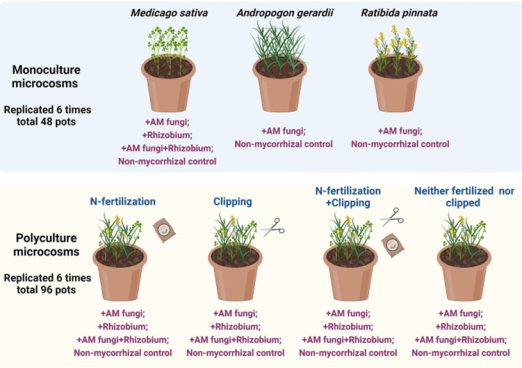Mycorrhizal and rhizobial interactions influence model grassland plant community structure and productivity
2022年03月14日 08:23
DOI:10.1007/S00572-021-01061-2
Zhou Jiqiong; Wilson Gail W T; Cobb Adam B; Zhang Yingjun; Liu Lin; Zhang Xinquan; Sun Feida
Abstract:
Arbuscular mycorrhizal (AM) fungi and rhizobium are likely important drivers of plant coexistence and grassland productivity due to complementary roles in supplying limiting nutrients. However, the interactive efects of mycorrhizal and rhizobial associations on plant community productivity and competitive dynamics remain unclear. To address this, we conducted a greenhouse experiment to determine the infuences of these key microbial functional groups on communities comprising three plant species by comparing plant communities grown with or without each symbiont. We also utilized N-fertilization and clipping treatments to explore potential shifts in mycorrhizal and rhizobial benefts across abiotic and biotic conditions. Our research suggests AM fungi and rhizobium co-inoculation was strongly facilitative for plant community productivity and legume (Medicago sativa) growth and nodulation. Plant competitiveness shifted in the presence of AM fungi and rhizobium, favoring M. sativa over a neighboring C4 grass (Andropogon gerardii) and C3 forb (Ratibida pinnata). This may be due to rhizobial symbiosis as well as the relatively greater mycorrhizal growth response of M. sativa, compared to the other model plants. Clipping and N-fertilization altered relative costs and benefts of both symbioses, presumably by altering host-plant nitrogen and carbon dynamics, leading to a relative decrease in mycorrhizal responsiveness and proportional biomass of M. sativa relative to the total biomass of the entire plant community, with a concomitant relative increase in A. gerardii and R. pinnata proportional biomass. Our results demonstrate a strong infuence of both microbial symbioses on host-plant competitiveness and community dynamics across clipping and N-fertilization treatments, suggesting the symbiotic rhizosphere community is critical for legume establishment in grasslands.
